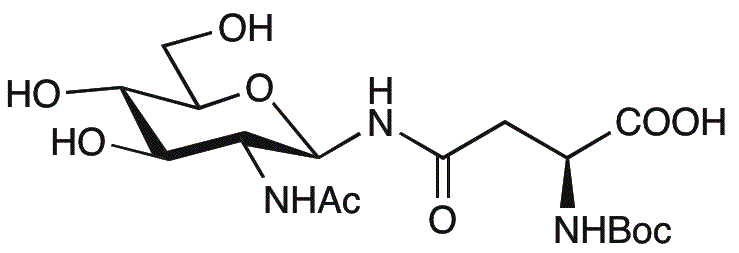Nw-(2-Acetamido-2-deoxy-b-D-glucopyranosyl)-Na-(tert-butoxycarbonyl)-L-asparagine is widely utilized in research focused on:
- Biotechnology: This compound serves as a building block for glycoproteins, which are essential in the development of biopharmaceuticals, enhancing drug stability and efficacy.
- Drug Development: Its unique structure allows for the design of targeted therapies, particularly in cancer treatment, by modifying drug delivery systems to improve bioavailability.
- Diagnostics: Used in the creation of diagnostic agents, it aids in the development of assays that can detect specific biomarkers, improving disease diagnosis accuracy.
- Food Industry: This compound can be applied in modifying food products to enhance nutritional profiles, particularly in developing functional foods that support health.
- Research Applications: It is valuable in academic research for studying carbohydrate-protein interactions, contributing to advancements in understanding cellular processes.
General Information
Properties
Safety and Regulations
Applications
Nw-(2-Acetamido-2-deoxy-b-D-glucopyranosyl)-Na-(tert-butoxycarbonyl)-L-asparagine is widely utilized in research focused on:
- Biotechnology: This compound serves as a building block for glycoproteins, which are essential in the development of biopharmaceuticals, enhancing drug stability and efficacy.
- Drug Development: Its unique structure allows for the design of targeted therapies, particularly in cancer treatment, by modifying drug delivery systems to improve bioavailability.
- Diagnostics: Used in the creation of diagnostic agents, it aids in the development of assays that can detect specific biomarkers, improving disease diagnosis accuracy.
- Food Industry: This compound can be applied in modifying food products to enhance nutritional profiles, particularly in developing functional foods that support health.
- Research Applications: It is valuable in academic research for studying carbohydrate-protein interactions, contributing to advancements in understanding cellular processes.
Documents
Safety Data Sheets (SDS)
The SDS provides comprehensive safety information on handling, storage, and disposal of the product.
Product Specification (PS)
The PS provides a comprehensive breakdown of the product’s properties, including chemical composition, physical state, purity, and storage requirements. It also details acceptable quality ranges and the product's intended applications.
Certificates of Analysis (COA)
Search for Certificates of Analysis (COA) by entering the products Lot Number. Lot and Batch Numbers can be found on a product’s label following the words ‘Lot’ or ‘Batch’.
Número de catálogo
Número de lote/lote
Certificates Of Origin (COO)
This COO confirms the country where the product was manufactured, and also details the materials and components used in it and whether it is derived from natural, synthetic, or other specific sources. This certificate may be required for customs, trade, and regulatory compliance.
Número de catálogo
Número de lote/lote
Safety Data Sheets (SDS)
The SDS provides comprehensive safety information on handling, storage, and disposal of the product.
DownloadProduct Specification (PS)
The PS provides a comprehensive breakdown of the product’s properties, including chemical composition, physical state, purity, and storage requirements. It also details acceptable quality ranges and the product's intended applications.
DownloadCertificates of Analysis (COA)
Search for Certificates of Analysis (COA) by entering the products Lot Number. Lot and Batch Numbers can be found on a product’s label following the words ‘Lot’ or ‘Batch’.
Número de catálogo
Número de lote/lote
Certificates Of Origin (COO)
This COO confirms the country where the product was manufactured, and also details the materials and components used in it and whether it is derived from natural, synthetic, or other specific sources. This certificate may be required for customs, trade, and regulatory compliance.

